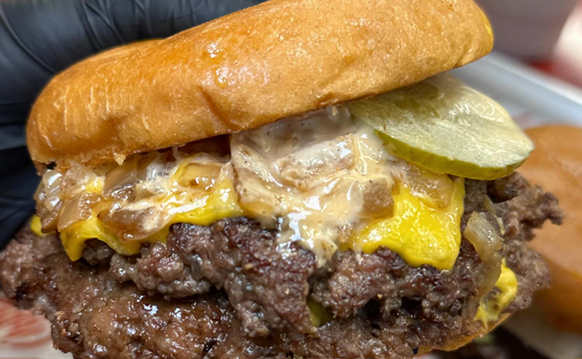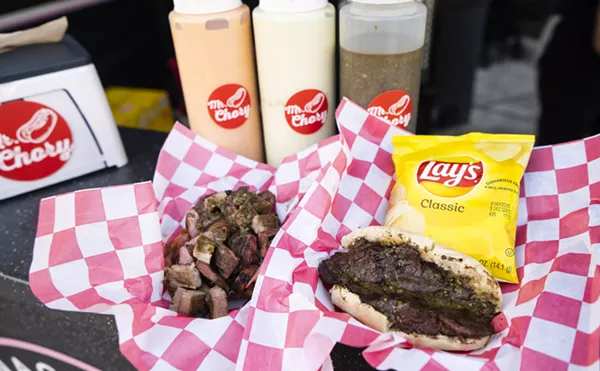"Be careful. That's very spicy."
Fuqi feipan, which translates as "married couple's lung slices," doesn't have any lung in it, and at Peppers, it doesn't have what most of us call beef in it either. Since its origins in 1930s Chengdu, fuqi feipan has come to mean any cold dish of organ meats in the namesake street-food vendors' signature sauce.
The plate of wafer-thin, transparent slices of al dente tendon and firm tendrils of cow stomach together in a warming oily glaze made quick trips around the table on a lazy Susan. It was a hit even with our group's tripe skeptics. The cool, clean textures, the chili-pepper finish of the marinade, and the crunchy garnish of crushed peanuts were a terrific start to the meal.
It was not, however, very spicy.
We wanted very spicy. Before we'd ordered anything, every one of us at our table of six looked the waiter in the eye and assured him that we were here for no-compromise Szechuan food — that we knew exactly what we were asking for — and we swore that we all drink Tabasco for breakfast. I was an occasional customer the staff recognized going back years. The owner knew me as someone who ordered some of the spiciest things on the menu and ate them with glee.
Yet even here, even now, we faced every adventurous eater's perennial dilemma: How to get the staff in ethnic restaurants to believe you when you say you want it like they eat it back home?
Peppers is my favorite Chinese restaurant in Broward County hands-down. Owner and Manager Jason Xu, a second-generation restaurateur, looks all too young to own a place as ambitious as this. He opened it four years ago with his wife, who now spends much of her time running their other venture, a sushi restaurant in Miramar. They stake out regional Chinese territory others don't. Good Hong Kong and Cantonese cooking are becoming easier to find each year, especially in Broward. Peppers, though, has dishes you simply can't get done right anywhere else in South Florida. Ask me where to go for Hong Kong and Cantonese standards and Peppers would be in my top five. Ask me where to go for proper Szechuan or Taiwanese food, though, and they're it. But damn if they don't make me work for it every time.
The fuqi feipan wasn't very spicy, but maybe it wasn't supposed to be. Every dish has its own ideal, after all, and it was pretty delicious.
As "Tony," our graceful, solicitous, and overprotective server, ladled out starched squid soup, enough for a table of eight for $6.95, a couple of us tried again, this time with a visualization exercise.
"We are not Americans. We are a family from Szechuan Province in China. We want the food a family from Western China would get." I felt silly, but this is what it had come to.
He laughed and took our entrée orders to the kitchen.
"Oh, this is nice," someone said, tasting the soup. Murmurs of assent came from most of the group for the exceedingly light-tasting thickened broth laced with drizzles of egg white and flecks of squid and fish paste in the simple, sometimes hardscrabble mode of much Taiwanese cooking. As we spooned it up and drank Tsingtao beer from Mr. Xu's hometown of Qingdao, it couldn't have provided a sharper contrast when the entrées began to arrive.
One more question, though. If you don't read Mandarin, how will you know which spicy chicken you'll get when you order spicy chicken ($10.95)? If you're familiar with the dish, it turns out that it's what is sometimes more descriptively translated as dry-cooked chicken with chilis. I've had theirs twice now, morsels of unbreaded fried chicken tossed with a whole lot of dried hot peppers, tiny pellets of scallion, and flecks of fresh ginger and garlic, clinging not so much to a sauce as a thin, oily mist. If, like most of us, your idea of "Szechuan" chicken involves a sweet-and-spicy brown sauce or a chili-and-tomato concoction bearing the name, this is something else entirely, with an unfamiliar, citrusy, herbal roundness to the heat, and though I didn't feel much of it, some at the table felt the anesthesia-like tingle Szechuan peppercorns are known for.
That additional flavor element has been especially rare in America these past decades even as "real" Szechuan restaurants began proliferating in California and New York in the 1990s. It remained virtually absent until last year, in part because of Florida. The flavor comes from the Szechuan peppercorn, actually a berry, which was barred from import into the United States until 2005 because it could carry citrus canker. In other words, Florida was part of the reason Chinese immigrants long insisted that Szechuan cooking in America never tasted right. In the past few years, Chinese producers began processing and packaging it in a way that passed USDA muster, and finally a whole raft of dishes from southwestern China can taste "right" without breaking federal law when in the right cooks' hands.
All was well, allowing me room here for the necessary digression on the restaurant itself. I'm not a stickler for décor at this sort of ethnic restaurant, but it's a bit nicer than most, with neutral walls and furniture, a couple of painted murals, garlands of silk chili peppers, and subdued lighting. Two small private rooms with karaoke machines are available for family gatherings and other small groups that want to make an afternoon or night of it, but though the place is usually fairly subdued, be warned that there is a big-screen TV by the counter that sometimes gets called into service for high-decibel karaoke when there's a party going on. Now that you have an idea of what the place is like, we can get back to the food.
The Szechuan peppercorns showed up again in Kung Pao frog legs, and the generous heap of tender drumettes leapt off the plate. As with their Kung Pao chicken, it bore only a passing resemblance to the dish of the same name at the local takeout. It was spicy, and it had peanuts in it. Beyond that, the light, clear, starch-free sauce felt closer in spirit to a Thai chili-and-basil preparation than it did to whatever goes into the ubiquitous cubed chicken and celery dish you probably know. It came spicy as we'd ordered it too, full of a slow-blooming heat, and only hinted at sweetness, not in the flavor but in the lemongrass-y scent coming from those peppers.
The whole fish in a spicy black bean sauce (market price) was an exemplary version of a widely available dish. Ours was a large, clean-tasting yellow snapper, head and tail intact, fried to a crisp and smothered in a wonderfully balanced — tangy, sweet, and hot — and coarsely textured sauce. If you're not keen on eating it in the traditional family style and picking the meat straight from the bones with your chopsticks, which is the easiest way to go about it, you may want to ask if it can be filleted in the kitchen before serving.
For an escape from the heat and a bit of color, bright green stalks of Chinese spinach with garlic ($10.99) offered some crunch and refreshment. Also on the mild side, we had a crock of the Taiwanese classic three flavors chicken, also commonly called three cups chicken because of the equal proportions of soy sauce, rice wine, and sesame oil that comprise the sweet-and-salty brown gravy that the bone-in chunks of chicken stew in. Whether via five-spice powder or, as I suspect, added on its own, the flavor of star anise gave the simple dish a lovely extra dimension.
There's lots more where that came from, of course. Another standout at a recent lunch visit was the surprisingly well-named "Boiled in Hot Sauce, Two Choices" ($11.95). A big bowl, in our case, of thick-cut slices of beef and flounder submerged in the depths of an incendiary, oily broth tasting of ginger and the twin proteins that were best enjoyed pulled from the depths with a few spoonfuls of the sauce over rice. They also offer a terrific hot pot for $18 a person. It's not on the menu, but on cooler winter days, it's not uncommon to walk into Peppers and find every single person in the restaurant having it. A stainless-steel bowl arrives on a portable gas burner. Alongside the boiling broth, your choice of a mild one, a fiery, red Szechuan-style one flavored with anise and peppercorns, or a divided bowl of both, your table gets an array of noodles, raw seafood, thin, rolled slices of lamb and other meats, tripe and tendon, and all sorts of vegetables to drop in. It's a great communal meal, and by the time you've been at it for a while, the broth has taken on loads of flavor from everything that's passed through it.
On my first visit to Peppers about four years ago for a humble $6 bowl of Szechuan beef noodles in soup and a bubble tea in the middle of a daylong bike ride, it was the little surprises that hooked me. The attention to textures and balanced flavor and the aversion to the sugar and cornstarch that almost define American Chinese cooking keep me coming back, even though it's twice as far from where I live as the other Chinese restaurants on my shortlist.












